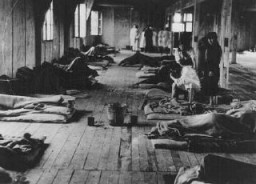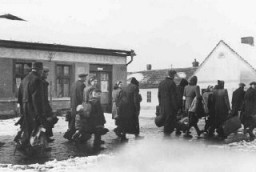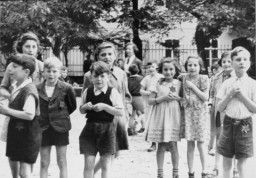Theresienstadt: SS and Police Structure
Unlike camps in the concentration camp system, the Theresienstadt "camp-ghetto" was subordinate to the SS officials who ran the Prague branch of the Central Office for Jewish Emigration. This reflected Theresienstadt's special status as a transit station. SS First Lieutenant Siegfried Seidl, who was responsible for establishing and commanding the camp-ghetto, reported directly to the chief of that office, SS Captain Hans Günther. Günther in turn reported to Adolf Eichmann at the Reich Security Main Office (RSHA) IV B 4 in Berlin.
As an SS- and police- managed installation, Theresienstadt was also under the authority of the Higher SS and Police Leader in Prague, SS Lieutenant General Karl Hermann Frank. Seidl was commandant from November 24, 1941, until July 3, 1943. SS First Lieutenant Anton Burger replaced Seidl and served as commandant of Theresienstadt until January 1944. SS First Lieutenant Karl Rahm replaced Burger, and remained commandant until the SS abandoned the camp on May 5, 1945.
The commandant's headquarters employed 28 SS members and/or SS candidate members. The officers and the non-commissioned officers were employees of the RSHA. The enlisted men, including clerical assistants and chauffeurs, were primarily ethnic Germans recruited from Slovakia. In addition, the commandant's headquarters employed 18 civilians, generally local residents, both ethnic German and Czech, in a variety of support positions (cooks, electricians, chauffeurs, etc.).
A Czech Special Department-Gendarmerie (Gendarmerie-Sonderabteilung) detailed from the Gendarmerie Provincial Detachment Bohemia and numbering between 150 and 170 men provided the perimeter guards for the Theresienstadt camp-ghetto. Gendarmerie Captain Theodor Janecek commanded the Special Detachment from November 1941 until the end of August 1943; Gendarmerie Lieutenant Miroslaus Hasenkopf replaced him on September 1, 1943. In order to prevent the development of contacts between the Jewish prisoners and the Czech guards, the SS ordered the Provincial Detachment Bohemia to rotate the personnel of the special department frequently.
The German political police department (Geheime Staatspolizei-Gestapo) established an interrogation-intelligence headquarters in the Small Fortress, located across the Ohre River from the camp-ghetto. This headquarters was specifically directed at the perceived "danger to the Reich" represented by the inhabitants of the camp-ghetto. In addition to identifying and eliminating any potential for resistance, the Small Fortress served as a Gestapo prison and as headquarters to evaluate intelligence about what was going on in the camp-ghetto and its environs.
Though most of those incarcerated and tortured in the Small Fortress were non-Jewish political prisoners, Gestapo officials also arrested, imprisoned, and killed Jews there, primarily from Litomerice and other Sudeten and Bohemian cities. Seventeen of the Jewish prisoners who survived their experience in the Small Fortress were sent across the river to Theresienstadt (eleven in 1942, five in 1943, and one in 1944).
Series: Theresienstadt
Critical Thinking Questions
- What was the role of Theresienstadt in the Nazi strategy of deception? How was it different from the majority of concentration camps and ghettos?
- Did other camps have multiple purposes? If so, what were they?
- Euphemisms, mild or indirect words or expressions substituted for ones considered to be too harsh or blunt, can hide dangerous or illegal behavior. What expressions did the Nazis use to disguise their intentions or policies?
- In what ways did the SS coordinate the activities of German and foreign police agencies to persecute perceived "enemies of the state"?







